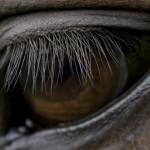Seeing Through the Horse’s Eyes

Though they have smaller and lighter bodies than some other animals, horses have eyes that are enormous in comparison to those of most land-dwelling mammals. These large eyes gather a lot of light, allowing the horse to see well on cloudy days and in places that are very poorly lit. Horses’ eyes don’t have the ability to adapt instantly to sudden changes from a lighter to a darker environment, such as when they go from a sunny field onto a shady forest trail. For this reason, riders should make these transitions at slower gaits and be ready to guide their mounts around obstacles until the horse’s vision adjusts to the lower level of light.
Predators such as members of the dog and cat families have eyes that face forward, but as a prey animal, the horse’s eyes are set on the sides of its head so that it can easily see the approach of danger from almost any angle. A horse does have blind spots, however, being unable to see things in a narrow space directly behind itself and also in a short cone-shaped area in front of its face. Without binocular vision in the space before it, a horse may raise or lower its head to get a better look at something in its path. Negotiating high, wide jumps and steep or uneven trails usually isn’t a problem for horses if they are allowed the freedom to move their heads as they approach obstacles and rough footing.
Anyone who handles or works around horses should be careful not to approach a horse quietly from directly behind it. Horses that suddenly notice something moving behind them will often startle, run, or kick in defense. Approaching at an angle and speaking to the horse will usually give it time to recognize humans as familiar, non-threatening creatures.








